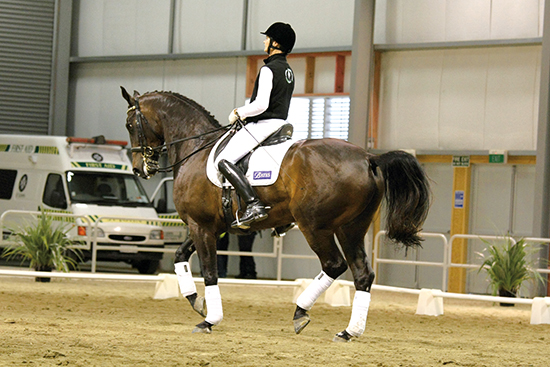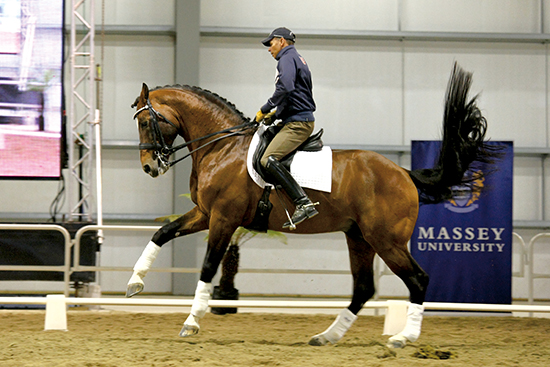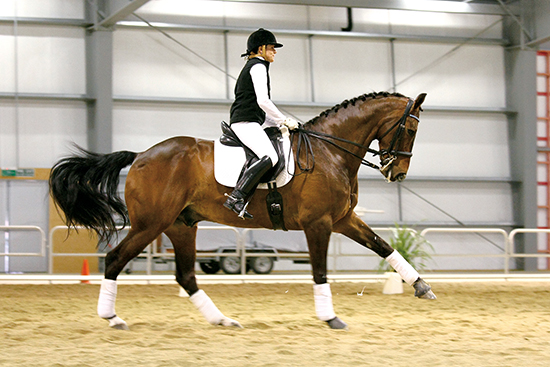 Words and photos: Annie Studholme
Words and photos: Annie Studholme
On to Grand Prix
In his training clinics at the New Zealand FEI Dressage Forum, American dressage star, Steffen Peters has been working with local riders and their horses – now he is working with one of the Kiwi’s better known Grand Prix riders, Louisa Hill.
Louisa Hill is riding the 17.1 hh Anamour gelding Bates Antonello, and Steffen immediately appreciates the cadence in his trot, but warns Louisa not to let it become too passage-like. This is determined by his hoof print; when he’s too passage-like, he’s not tracking up.
To correct it, Steffen wants Antonello moving more forward. In the flying changes, he says it’s important the horse understands the difference between the changing aid and the straightening aid.
Louisa Hill – working with Bates Antonello on his trot
Steffen says it’s about testing the sensitivity to the leg aid in the collection, rather than just sending them forward around the arena. He wants to see clear, easy aids, not putting the leg too far back.
When Antonello switches leads, Steffen says simply change back, not go to walk or trot and reorganise. Just keep doing it until he gets the point.
The flying changes are happening, but he’s looking for a little too much support. It’s all about improving the sensitivity to the legs and Steffen wants to see Louisa using clear easy aids and not putting her legs too far back.
“If you are aiming more and more for Grand Prix, then he needs to listen to more refined aids, especially in the one-tempi. Even though the quality of the change is quite good and they were pretty straight, and that he is quite confirmed in the changes, let’s find out what happens if we sit perfectly in the centre with the legs less far back. If he doesn’t listen, you need to be more direct,” says Steffen.
“To me there is nothing more beautiful than being able to ride those changes just from the leg aid. If he is behind the leg then move your leg further back and make your point. But especially when you are asking for one-tempis later he needs to be much more refined on that.”
Once he can cope with that simplicity in the two-tempis, Steffen says “he’ll put money on him” being able to do the one-tempi changes in the near future.
Overall, Steffen was thrilled with Antonello’s work, but says he still needs to be more sensitive.
“Honestly quite nice Louisa. I think he’s a wonderful horse. Keep him really, really honest to your aids. At the end of the day you only have three aids to communicate with him and you need to test the honesty of those aids – there is no fourth or fifth aid.”
Flying Changes – single to sequence
Working in reverse, Steffen starts with the most advanced horse first, the 12-year-old small tour stallion Prestige VDL and Lisa Blackbourn, asking for two-tempi changes.
He wants to see them ridden slightly more forward; Lisa is tending to be too careful.
“Find the tempo that you find is most controllable and then develop the one-tempi from there. Two tempis when you’re ready, but again my point, when you are ready!”
Working through the changes – Steffen and Prestige
Steffen wants Lisa to spend more time establishing the collection, the self-carriage, the control, rideability, instead of being preoccupied about the changes themselves.
Steffen climbs on-board. He rides just as he teaches, sticking to lots of transitions, expecting Prestige VDL to come back to him when he uses the snaffle rein and closes his legs gently; he is really looking for that release, over and over again.
He says the horse’s problem in the changes is that he simply wants to go too forward.
When Steffen tries to do a single flying change on Prestige VDL, he finds it difficult to re-establish collection, self-carriage and straightness afterwards.
“In the two-tempi at least it’s not so much the flying change itself, that’s a little bit if an issue, but it’s the strides in between. You simply don’t have that time in the one-tempi to be re-establishing the stride.”
Steffen is not a big fan of just drilling the one-tempi. He says your best and most productive attempt is always your very first one, as afterwards it’s harder and harder because the horses get a little tense.
Steffen says with Ravel he had huge problems with the one-tempi. Tempting as it was to do them every day, often it was best to leave it for a couple of days and come back to it. It took time but eventually it happened.
Moving onto Vanessa Way and KH Arvan, Steffen starts with a sequence of four-tempi changes. He reminds Vanessa to think about the geometry of the changes. It should be second nature that we are starting the third change on X.
Vanessa Way and KH Arvan, try for some fours
Vanessa and Arvan’s changes are technically correct and cover a lot of ground, but there is a lack of expression.
Since Arvan is so confirmed in his changes, Steffen advises Vanessa to “…ride into the flying change a tiny bit collected and as soon as you feel a change is happening, give another forward pushing aid” to help create that extra expression but staying careful not to get too fast.
Again, both Arvan’s two-tempi and one-tempi changes were technically correct but executed too fast. Steffen says it is a big risk to ride just forward; the horse needs to be collected. “They are after all, called a flying change. They are supposed to fly for a moment.”
When Vanessa gets Arvan more collected, his one-tempi changes markedly improved.
Steffen finishes up working with Andrea Bank on the young Dressage Royal stallion, Doringcourt. Here he finds there is a tendency for the horse to be a little late behind in a single change, and kicks up behind.
Steffen asks for a single flying change on the diagonal. “We know already if he pushes a against your right leg, we’re going to get a little resistance, get a little buck and we’ll most likely get a flying change that is late behind. Let’s not make the mistake of allowing him to drift to the right. Let’s not make the mistake of flexing to the left too much.”
Like many young horses, Doringcourt starts anticipating the changes. To fix the problem, Steffan likes to pick lines where the horse is not thinking about the flying change.
Working from the counter-canter, if he changes, Steffen says to simply change back without changing back to walk. If he gets upset, then reorganise in walk.
“It’s so important we stay calm. Horses should be entitled to make mistakes, and right there we are just explaining and communicating with him. He simply needs to understand what we’re looking for.”
Asking again for the flying change from counter canter right, Doringcourt duly obliges. They repeat on the other side. Steffen uses some canter extensions to help achieve collection.
Steffen emphasises how important it is for the rider to learn how to ride a flying change. Those horses with a big canter (like Ravel) will always find them more difficult. It requires twice the co-ordination to control a big flying change.
Steffen says the trick to establishing flying changes is start tapping the horse’s natural ability to do them from an early age, but be patient.
This article first appeared in the January 2010 issue of THM.
Want more from Steffen? There’s lots and lots, just go to his Who’s Who entry to find the directory:

